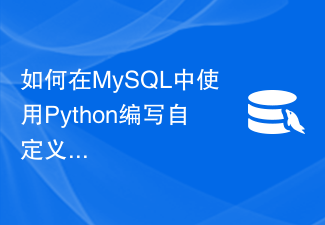 Web Front-end
Web Front-end JS Tutorial
JS Tutorial The ten most commonly used custom functions in javascript (Chinese version)_javascript skills
The ten most commonly used custom functions in javascript (Chinese version)_javascript skills(10)addEvent
The most popular version on the Internet is Scott Andrew's. It is said that the JavaScript community once held a competition (we can see this event on page 100 of Pro Javascript Techniques) or browse the PPK website to solicit additions of events and The function that removes the event, he is its winner. The following is his implementation:
function addEvent(elm, evType , fn, useCapture) {
if (elm.addEventListener) {
elm.addEventListener(evType, fn, useCapture);//DOM2.0
return true;
}
else if (elm.attachEvent) {
var r = elm.attachEvent('on' evType, fn);//IE5
return r;
}
else {
elm['on' evType] = fn;//DOM 0
}
}
The following is Dean Edwards’ version
// addEvent/removeEvent written by Dean Edwards, 2005
// with input from Tino Zijdel
// http:// dean.edwards.name/weblog/2005/10/add-event/
function addEvent(element, type, handler) {
//Assign a unique ID to each event handler function
if ( !handler.$$guid) handler.$$guid = addEvent.guid;
//Create a hash table for the event type of the element
if (!element.events) element.events = {};
//Create a hash table of event handlers for each "element/event" pair
var handlers = element.events[type];
if (!handlers) {
handlers = element .events[type] = {};
//Storage existing event handlers (if any)
if (element["on" type]) {
handlers[0] = element["on " type];
}
}
//Save the event handler function into the hash table
handlers[handler.$$guid] = handler;
//Assign a global event The handler function does all the work
element["on" type] = handleEvent;
};
//Counter used to create unique IDs
addEvent.guid = 1;
function removeEvent(element, type, handler) {
//Delete event handler function from hash table
if (element.events && element.events[type]) {
delete element.events[type ][handler.$$guid];
}
};
function handleEvent(event) {
var returnValue = true;
//Capture the event object (IE uses the global event object)
event = event || fixEvent(window.event);
//Get a reference to the hash table of the event handling function
var handlers = this.events[event.type];
// Execute each handler function
for (var i in handlers) {
this.$$handleEvent = handlers[i];
if (this.$$handleEvent(event) === false) {
returnValue = false;
}
}
return returnValue;
};
//Add some "missing" functions to IE's event object
function fixEvent(event) {
//Add standard W3C method
event.preventDefault = fixEvent.preventDefault;
event.stopPropagation = fixEvent.stopPropagation;
return event;
};
fixEvent.preventDefault = function() {
this.returnValue = false;
};
fixEvent.stopPropagation = function() {
this.cancelBubble = true;
};
The function is very powerful and solves the this pointing problem of IE. Event is always passed in as the first parameter, making cross-browser easy.
In addition, I also treasured a version of the HTML5 working group:
var addEvent=(function(){
if(document.addEventListener){
return function(el,type,fn){
if(el.length){
for( var i=0;i
}
}else{
el.addEventListener(type,fn, false);
}
};
}else{
return function(el,type,fn){
if(el.length){
for(var i=0 ;i
}
}else{
el.attachEvent('on' type,function() {
return fn.call(el,window.event);
});
}
};
}
})();
(9) addLoadEvent()
I have discussed this function before. Without going into details, it is just a little slow. Major libraries basically ignore it and implement the domReady version by themselves. The following is Simon Willison's implementation:
var addLoadEvent = function( fn) {
var oldonload = window.onload;
if (typeof window.onload != 'function') {
window.onload = fn;
}else {
window.onload = function() {
oldonload();
fn();
}
}
}
(8) getElementsByClass()
I have a collecting habit and have many versions on hand, and finally I brainstormed and implemented one myself. The following is my implementation:
var getElementsByClassName = function (searchClass , node,tag) {
if(document.getElementsByClassName){
return document.getElementsByClassName(searchClass)
}else{
node = node || document;
tag = tag || "*";
var classes = searchClass.split(" "),
elements = (tag === "*" && node.all)? node.all : node.getElementsByTagName(tag),
patterns = [],
returnElements = [],
current,
match;
var i = classes.length;
while(--i >= 0){
patterns.push(new RegExp("(^|\s)" classes[i] "(\s|$)"));
}
var j = elements.length;
while( --j >= 0){
current = elements[j];
match = false;
for(var k=0, kl=patterns.length; k
if (!match) break;
}
if (match) returnElements.push(current);
}
return returnElements;
}
}
(7) cssQuery()
The alias is getElementsBySeletor, which was first implemented by Dean Edwards. Prototype.js, JQuery and other class libraries are There is a corresponding implementation, among which JQuery integrates it into the $() selector, and its reputation exceeds that of its predecessors. However, cutting-edge browsers such as IE8 have already implemented the querySelector and querySelectorAll methods. When IE6 and IE7 are scrapped, they will be useless. Wuyou has an explanation of its implementation principles. Because it's too long, it won't stick out. You can check the original author's website for details.
(6) toggle()
is used to show or hide a DOM element.
function toggle(obj) {
var el = document.getElementById(obj);
if ( el.style.display != 'none' ) {
el.style.display = 'none';
}
else {
el .style.display = '';
}
}
(5) insertAfter()
DOM only provides insertBefore, it is necessary for us to implement insertAfter ourselves. But I think insertAdjacentElement is a better choice. Now all browsers except Firefox implement this method. Here is Jeremy Keith’s version:
function insertAfter(parent, node, referenceNode) {
parent.insertBefore(node, referenceNode.nextSibling);
}
(4) inArray()
is used to determine whether something exists in the check array value, the following methods are taken from the Prototype class library.
Array.prototype.inArray = function (value) {
for (var i=0,l = this.length ; i
return true;
}
}
return false;
};
Another version:
var inArray = function (arr,value) {
for (var i=0,l = arr.length ; i
return true;
}
}
return false;
};
(3) getCookie(), setCookie(), deleteCookie()
Those who make BBS and commercial websites should use it frequently. There is no reason to ask users to enter a password to log in every time. We need to use cookies to implement the automatic login function.
function getCookie( name ) {
var start = document.cookie.indexOf( name "=" );
var len = start name.length 1;
if ( ( !start ) && ( name != document.cookie.substring( 0, name.length ) ) ) {
return null;
}
if ( start == -1 ) return null;
var end = document.cookie.indexOf( ';', len );
if ( end == -1 ) end = document.cookie.length;
return unescape( document.cookie.substring( len, end ) );
}
function setCookie( name, value, expires, path, domain, secure ) {
var today = new Date();
today.setTime( today.getTime() );
if ( expires ) {
expires = expires * 1000 * 60 * 60 * 24;
}
var expires_date = new Date( today.getTime() (expires) );
document.cookie = name '=' escape( value )
( ( expires ) ? ';expires=' expires_date.toGMTString() : '' ) //expires.toGMTString()
( ( path ) ? ';path=' path : '' )
( ( domain ) ? ';domain=' domain : '' )
( ( secure ) ? ';secure' : '' );
}
function deleteCookie( name, path, domain ) {
if ( getCookie( name ) ) document.cookie = name '='
( ( path ) ? ';path=' path : '')
( ( domain ) ? ';domain=' domain : '' )
';expires=Thu, 01-Jan-1970 00:00:01 GMT';
}
(2)getStyle()与setStyle()
所有UI控件都应该存在的函数,动态设置样式与获取样式。这个可以写得很短,也可以写得很长,但要精确取得样式,一个字:难!但我发现许多问题都是发端于IE,微软的开发人员好像从来不打算给出getComputedStyle这样的函数,与之相近的currentStyle会返回auto,inhert, ' '等让你哭笑不得的值,这还没有算上IE怪癖模式带来的难度呢!各类库的实现是非常长与难分离出来的,下面是我实现的版本:
function setStyle(el,prop,value){
if(prop == "opacity" && ! "v1"){
//IE7 bug:filter 滤镜要求 hasLayout=true 方可执行(否则没有效果)
if (!el.currentStyle || !el.currentStyle.hasLayout) el.style.zoom = 1;
prop = "filter";
if(!!window.XDomainRequest){
value ="progid:DXImageTransform.Microsoft.Alpha(style=0,opacity=" value*100 ")";
}else{
value ="alpha(opacity=" value*100 ")"
}
}
el.style.cssText = ';' (prop ":" value);
}
function getStyle(el, style){
if(! "v1"){
style = style.replace(/-(w)/g, function(all, letter){
return letter.toUpperCase();
});
return el.currentStyle[style];
}else{
return document.defaultView.getComputedStyle(el, null).getPropertyValue(style)
}
}
有关setStyle还可以看我另一篇博文,毕竟现在设置的样式都是内联样式,与html混杂在一起。
(1)$()
实至名归,最值钱的函数,可以节省多少流量啊。最先由Prototype.js实现的,那是洪荒时代遗留下来的珍兽,现在有许多变种。
function $() {
var elements = [];
for (var i = 0; i var element = arguments[i];
if (typeof element == 'string')
element = document.getElementById(element);
if (arguments.length == 1)
return element;
elements.push(element);
}
return elements;
}
 深入解析JS自定义函数的声明和调用Aug 03, 2022 pm 07:28 PM
深入解析JS自定义函数的声明和调用Aug 03, 2022 pm 07:28 PM函数是一组执行特定任务(具有特定功能)的,可以重复使用的代码块。除了使用内置函数外,我们也可以自行创建函数(自定义函数),然后在需要的地方调用这个函数,这样不仅可以避免编写重复的代码,还有利于代码的后期维护。
 如何在MySQL中使用Python编写自定义函数Sep 22, 2023 am 08:00 AM
如何在MySQL中使用Python编写自定义函数Sep 22, 2023 am 08:00 AM如何在MySQL中使用Python编写自定义函数MySQL是一种开源的关系型数据库管理系统,常用于存储和管理大量的数据。而Python作为一种强大的编程语言,能够与MySQL进行无缝的集成。在MySQL中,我们经常需要使用自定义函数来完成一些特定的计算或数据处理操作。本文将介绍如何使用Python编写自定义函数,并将其集成到MySQL中。对于编写自定义函数,
 如何在MySQL中使用PHP编写自定义存储过程和函数Sep 21, 2023 am 11:02 AM
如何在MySQL中使用PHP编写自定义存储过程和函数Sep 21, 2023 am 11:02 AM如何在MySQL中使用PHP编写自定义存储过程和函数在MySQL数据库中,存储过程和函数是可以让我们在数据库中创建自定义的逻辑和功能的强大工具。它们可以用于执行复杂的计算、数据处理和业务逻辑。本文将介绍如何使用PHP编写自定义存储过程和函数,并附上具体的代码示例。连接到MySQL数据库首先,我们需要使用PHP的MySQL扩展来连接到MySQL数据库。可以使用
 PHP 用户自定义函数的创建Apr 14, 2024 am 09:18 AM
PHP 用户自定义函数的创建Apr 14, 2024 am 09:18 AMPHP自定义函数允许封装代码块,简化代码并提高可维护性。语法:functionfunction_name(argument1,argument2,...){//代码块}。创建函数:functioncalculate_area($length,$width){return$length*$width;}。调用函数:$area=calculate_area(5,10);。实践案例:使用自定义函数计算购物车中商品总价,简化代码和提高可读性。
 如何在PHP中自定义函数May 18, 2023 pm 04:01 PM
如何在PHP中自定义函数May 18, 2023 pm 04:01 PM在PHP中,函数是一组可重复使用的代码块,它们通过一个名称来标识。PHP支持大量现成的函数,如array_push、explode等,但有时候你需要编写自己的函数以实现特定的功能或提高代码复用性。在这篇文章中,我将介绍如何在PHP中自定义函数,包括函数声明、调用和使用函数参数。函数的声明在PHP中声明函数需要使用关键词function。函数的基本语法如下:
 Python 函数编程的基础知识介绍Apr 11, 2023 pm 10:49 PM
Python 函数编程的基础知识介绍Apr 11, 2023 pm 10:49 PM函数基础知识掌握自定义函数的基本语法规范和调用方法及掌握函数的各种参数的使用及调用规则。1、Python函数函数( Function )是组织好的,可重复使用的,用来实现单一, 或相关联功能的代码段。函数能提高应用的模块性 ,和代码的重复利用率。我们已经接触过Python提供的许多内建函数 ,比如print()。但你也可以自己创建函数,这被叫做用户自定义函数。2、自定义一个函数基本规则你可以定义一个由自己想要功能的函数,以下是简单的规则:函数代码块以 def关键词开头,后接函数标识符名称和圆括号
 Golang函数的内建函数和自定义函数的优劣比较May 16, 2023 pm 08:51 PM
Golang函数的内建函数和自定义函数的优劣比较May 16, 2023 pm 08:51 PMGolang是一门非常流行的编程语言,其拥有非常强大的函数库。在Golang中,函数被视为一等公民,这意味着Golang的函数可以像变量一样被传递、复制以及重载。此外,Golang还提供了内建函数和自定义函数两种类型。在本文中,我们将探讨Golang函数的内建函数和自定义函数的优劣比较,以帮助读者了解何时选择哪一种类型的函数。首先,让我们看看内建函数。内建函
 一文详解JavaScript函数中的参数Aug 03, 2022 pm 07:49 PM
一文详解JavaScript函数中的参数Aug 03, 2022 pm 07:49 PM函数参数是函数内部跟函数外部沟通的桥梁。下面本篇文章就来带大家了解一下JavaScript函数中的参数,希望对大家有所帮助!


Hot AI Tools

Undresser.AI Undress
AI-powered app for creating realistic nude photos

AI Clothes Remover
Online AI tool for removing clothes from photos.

Undress AI Tool
Undress images for free

Clothoff.io
AI clothes remover

AI Hentai Generator
Generate AI Hentai for free.

Hot Article

Hot Tools

mPDF
mPDF is a PHP library that can generate PDF files from UTF-8 encoded HTML. The original author, Ian Back, wrote mPDF to output PDF files "on the fly" from his website and handle different languages. It is slower than original scripts like HTML2FPDF and produces larger files when using Unicode fonts, but supports CSS styles etc. and has a lot of enhancements. Supports almost all languages, including RTL (Arabic and Hebrew) and CJK (Chinese, Japanese and Korean). Supports nested block-level elements (such as P, DIV),

Notepad++7.3.1
Easy-to-use and free code editor

MinGW - Minimalist GNU for Windows
This project is in the process of being migrated to osdn.net/projects/mingw, you can continue to follow us there. MinGW: A native Windows port of the GNU Compiler Collection (GCC), freely distributable import libraries and header files for building native Windows applications; includes extensions to the MSVC runtime to support C99 functionality. All MinGW software can run on 64-bit Windows platforms.

Atom editor mac version download
The most popular open source editor

SublimeText3 Linux new version
SublimeText3 Linux latest version





